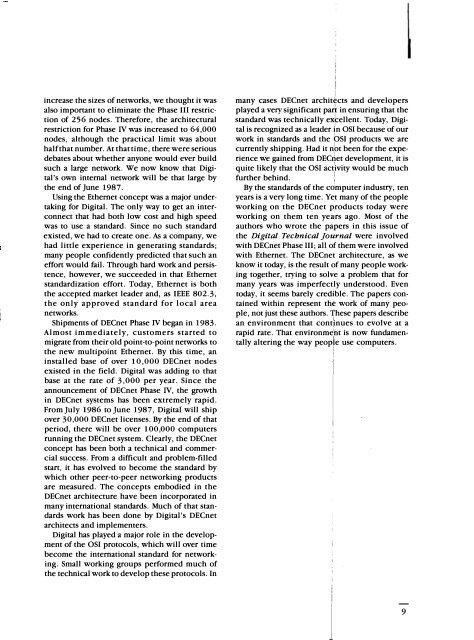DTJ Number 3 September 1987 - Digital Technical Journals
DTJ Number 3 September 1987 - Digital Technical Journals
DTJ Number 3 September 1987 - Digital Technical Journals
Create successful ePaper yourself
Turn your PDF publications into a flip-book with our unique Google optimized e-Paper software.
increase the sizes of networks, we thought it wasalso important to eliminate the Phase III restrictionof 256 nodes. Therefore, the architecturalrestriction for Phase IV was increased to 64,000nodes, although the practical limit was abouthalf that number. At that time, there were seriousdebates about whether anyone would ever buildsuch a large network. We now know that <strong>Digital</strong>'sown internal network will be that large bythe end of June <strong>1987</strong>.Using the Ethernet concept was a major undertakingfor <strong>Digital</strong>. The only way to get an interconnectthat had both low cost and high speedwas to use a standard. Since no such standardexisted, we had to create one. As a company, wehad little experience in generating standards;many people confidently predicted that such aneffort would fail. Through hard work and persistence,however, we succeeded in that Ethernetstandardization effort. Today, Ethernet is both.the accepted market leader and, as IEEE 802.3,the only approved standard for local areanetworks.Shipments of DECnet Phase IV began in 1983.Almost immediately, customers started tomigrate from their old point-to-point networks tothe new multipoint Ethernet. By this time, aninstalled base of over 10,000 DECnet nodesexisted in the field. <strong>Digital</strong> was adding to thatbase at the rate of 3,000 per year. Since theannouncement of DECnet Phase IV, the growthin DECnet systems has been extremely rapid.From July 1986 to June <strong>1987</strong>, Digitafwill shipover 30,000 DECnet licenses. By the end of thatperiod, there will be over 100,000 computersrunning the DECnet system. Clearly, the DECnetconcept has been both a technical and commercialsuccess. From a difficult and problem-filledstart, it has evolved to become the standard bywhich other peer-to-peer networking productsare measured. The concepts embodied in theDECnet architecture have been incorporated inmany international standards. Much of that standardswork has been done by <strong>Digital</strong>'s DECnetarchitects and implementers.<strong>Digital</strong> has played a major role in the developmentof the OSI protocols, which will over timebecome the international standard for networking.Small working groups performed much ofthe technical work to develop these protocols. Inimany cases DECnet architects and developersIplayed a very significant part in ensuring that thestandard was technically exFellent. Today, <strong>Digital</strong>is recognized as a leader in OSI because of ourIwork in standards and the OSI products we arecurrently shipping. Had it npt been for the experiencewe gained from DECriet development, it isIquite likely that the OSI activity would be muchfurther behind. !By the standards of the cdmputer industry, tenyears is a very long time. Ye.t many of the peopleworking on the DECnet products today wereworking on them ten years ago. Most of theauthors who wrote the papers in this issue ofthe <strong>Digital</strong> <strong>Technical</strong> jo urnal were involvedwith DECnet Phase III; all of them were involvedwith Ethernet. The DECnet architecture, as weknow it today, is the result of many people workingtogether, trying to solve a problem that formany years was imperfectly understood. Eventoday, it seems barely credible. The papers containedwithin represent the work of many people,not just these authors. These papers describeIan environment that continues to evolve at arapid rate. That environment is now fundamen-1tally altering the way peope use computers.i9









